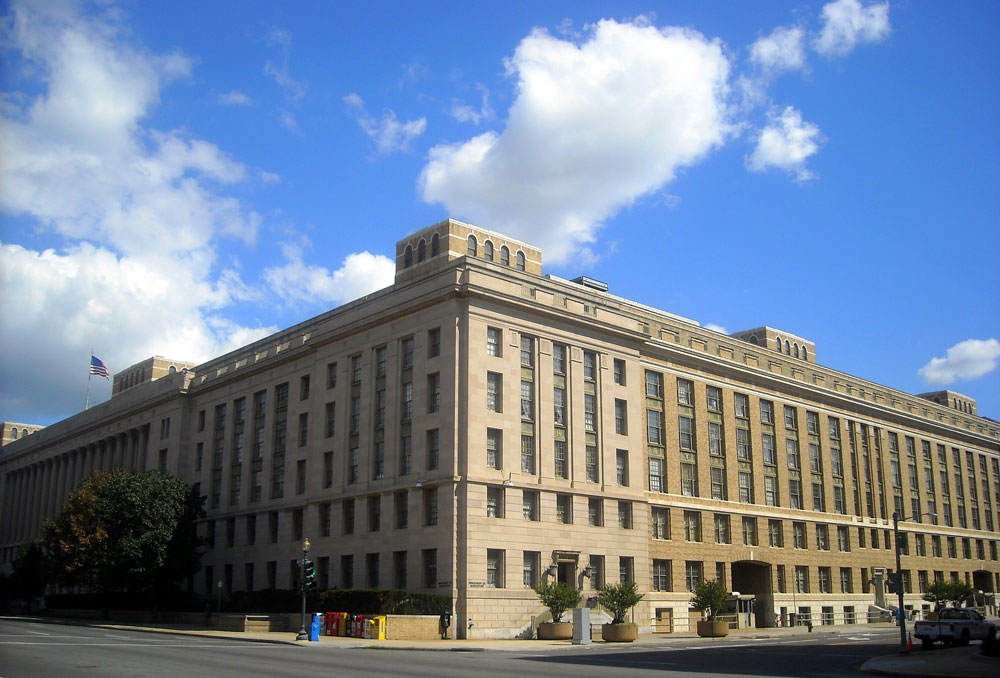
The U.S. Department of Agriculture will pay about half of November benefits for the Supplemental Nutrition Assistance Program, or SNAP, though benefits could take months to flow to recipients, the department said Monday in a brief to a federal court in Rhode Island.
A four-page report from the USDA answered U.S. District Chief Judge John J. McConnell Jr.’s order that President Donald Trump’s administration pay at least a portion of benefits to the 42 million people who receive assistance through the program by the end of Wednesday, despite the government shutdown.
The USDA action does not address what would happen if the shutdown stretches beyond November.
Leading Democrats in Congress blasted the administration’s decision to pay only part of the month’s benefits, saying Trump was willfully denying food assistance to needy Americans. “Providing partial benefits is not enough, is not compliant with the law, and it’s particularly cruel of Trump with the Thanksgiving season around the corner,” said Senate Democratic Leader Chuck Schumer of New York.
McConnell on Saturday laid out two options for the administration: pay for partial benefits by the end of Wednesday through a contingency fund which currently has about $4.65 billion available, or pay for a full month of benefits by tapping other reserve sources such as the child nutrition program by the end of Monday.
USDA opted to use the contingency fund, giving the department until the end of Wednesday to pay out benefits.
But a declaration from Patrick A. Penn, USDA’s deputy under secretary for food, nutrition and consumer services, said the administrative hurdles in calculating and delivering a half-month’s portion of benefits could take “anywhere from a few weeks to up to several months.”
The department was complying with McConnell’s order by starting the process of resuming payments Monday, according to the status report signed by U.S. Justice Department officials.
USDA “will fulfill its obligation to expend the full amount of SNAP contingency funds today by generating the table required for States to calculate the benefits available for each eligible household in that State,” they said. “USDA will therefore have made the necessary funds available and have authorized the States to begin disbursements once the table is issued.”
Delayed SNAP benefits in shutdown
McConnell’s order acknowledged that calculating reduced benefits would take the government some time, which he explained was why he gave USDA until Wednesday if the department chose that path.
But Penn said Monday that was not nearly enough time, in part due to some states’ outdated systems for processing benefits.
The federal government would provide states with updated tables for benefits at the partial funding level by Monday, he said. States will then need to send updated files to the vendors that process benefits and add them to beneficiaries’ debit-like EBT cards to be spent on groceries.
Monday marked the 34th day of the federal government shutdown, which began Oct. 1 when Congress failed to appropriate money for federal programs or pass a stopgap spending bill.
The U.S. Senate was expected to hold another procedural vote to move forward the House-passed GOP stopgap bill that would fund the government at fiscal 2025 levels until Nov. 21.
Democrats have voted against that measure in a bid to force negotiations on expiring tax credits for people who buy health insurance on the Affordable Care Act marketplace.
On Tuesday, the funding lapse will tie for the longest shutdown in history, which took place between 2018 and 2019.
Contingency fund dispute
Leading up to the end of October, the administration had warned it could not pay SNAP benefits for this month amid the shutdown, saying it was legally forbidden from using the contingency fund that was supposed to be for natural disasters and similar emergencies.
But two federal judges ruled Oct. 31 that USDA not only could use the fund, but was obligated to in order to keep SNAP benefits flowing.
Saturday marked the first lapse in benefit payments in the modern history of the program that dates to part of President Lyndon B. Johnson’s War on Poverty agenda.
Lawmakers, advocates and SNAP experts said users of the program would see a delay in November benefits as the administration worked to restart it.
The administration’s insistence it could not use its contingency fund, originally appropriated by Congress at $6 billion, was a reversal from a Sept. 30 USDA plan on how to operate in a shutdown, which explicitly called for use of the fund to keep issuing benefits.
A month of SNAP benefits costs the federal government about $9 billion.
While USDA would not use the contingency fund to pay for regular benefits, it did spend about $750 million of the original $6 billion for other uses in October, according to a Monday declaration to the court by Penn.
The department spent about $450 million for state administrative expenses and $300 million for block grants to Puerto Rico and American Samoa, Penn wrote.
The department would again allocate $450 million for administrative expenses in November, and $150 million for the block grants to territories, he added.
That left $4.65 billion available for November benefits, Penn wrote.
No use of child nutrition funds
Penn also explained USDA’s decision not to use a fund for a child nutrition program to cover shortfall for SNAP benefits.
The administration wanted to keep that fund fully stocked, he said.
“Child Nutrition Program funds are not a contingency fund for SNAP,” he said. “Using billions of dollars from Child Nutrition for SNAP would leave an unprecedented gap in Child Nutrition funding that Congress has never had to fill with annual appropriations, and USDA cannot predict what Congress will do under these circumstances.”
The child nutrition program funds school meals, summer meals for children and summer EBT benefits for low-income families with children. The school lunch program alone serves about 29 million children per day, Penn said.
Democrats call USDA plan ‘not acceptable’
Democrats expressed dismay that the administration opted not to fully fund November benefits.
“Just now paying the bare minimum to partially fund SNAP is not enough, and it is not acceptable,” Sen. Patty Murray of Washington state wrote in a social media post Monday.
“Trump should immediately work to fully fund benefits under the law,” added Murray, who serves as the top Democrat on the Senate Appropriations Committee.
Rep. Rosa DeLauro, ranking member of the House Appropriations panel, said “this was entirely avoidable,” noting that Trump “chose to hold hungry children, seniors, and veterans hostage in a selfish and cruel attempt to gain political advantage.”
“Now, only partial benefits will be sent out late, and families will go hungry, while this administration continues to host lavish parties for their billionaire donors and political allies,” the Connecticut Democrat said.
She added that “we are in this situation because of a lack of political will on the part of the Trump administration” and urged USDA “to put politics aside and use the money they have available to ensure families do not go hungry.”
Speaker Johnson defends Trump
At a press conference Monday, U.S. House Speaker Mike Johnson continued to defend Trump’s handling of the SNAP payments.
The president is “desperate for SNAP benefits to flow to the American citizens who desperately rely upon it,” Johnson said.
The Louisiana Republican echoed Agriculture Secretary Brooke Rollins’ Friday claim that sought to justify her agency’s refusal to tap into the contingency fund to pay for SNAP.
“The way we always understood it was: The contingency fund could not be used legally if the underlying fund was suspended,” Johnson said.
He blamed congressional Democrats for voting against the stopgap spending bill and noted that two judges, McConnell and Indira Talwani in Massachusetts federal court, who separately ordered payments resume, were appointed by Democratic former President Barack Obama.
Talwani ruled Friday that the USDA plan to pause SNAP was illegal — but gave the Trump administration until Monday to respond to her finding before she decides on a motion to force the benefits be paid despite the ongoing government shutdown.
Johnson also acknowledged the complex logistics of releasing the money to states.
“So, it’s not as easy as hitting go send on a computer — you gotta go through and recalculate partial payments to the 42 million recipients of the program,” Johnson said. “That puts a huge burden on states and on the feds to try to figure that out in short order.”
–Jacob Fischler, Shauneen Miranda, Florida Phoenix





























Al says
This is a learning moment, never depend on the government. Now is a great time to get off the couch and get a job. If your only working 40 hours a week there’s enough time left to work 40 more. If you have better things to do then starve, your choice.
joe says
“If your only working 40 hours a week there’s enough time left to work 40 more.”
Oh sure, a family with children should have the father working 80 hours a week – leaving the mother and children to basically fend for themselves while Dad tries to get enough sleep to function at two jobs. And maybe Mom should get a job too, right? and leave the kids to fend for themselves.
You do know that over 70% of people getting SNAP benefits are already working full-time – but unfortunately, many (if not most) are working for employers too cheap to pay a living wage – Amazon, WalMart, etc.–
Your assumption that SNAP recipients are “sitting on the couch” and not working displays your ignorance of reality and your spewing of the long-discounted right wing bullshit about poor people.
Deborah Coffey says
The learning moment is: NEVER trust Donald Trump’s government. And, there are working requirements for SNAP benefits. Are you working 80 hours a week? Try it and then see if you’d wish it on others. Your comment is really insensitive, Al.
Erod says
You only have Chuck Schumer & Hakeem Jeffries to blame. They are more concerned about thier power than you wellbeing.
Sherry says
So erod. . . you are absolutely fine with healthcare premiums almost doubling come Jan. 1st? Please change the channel from Fox!
WASHINGTON (AP) — Senate Majority Leader John Thune quickly swatted down a Democratic offer to reopen the government and extend expiring health care subsidies for a year, calling it a “nonstarter” as the partisan impasse over the shutdown continued into its 38th day.
Senate Democratic Leader Chuck Schumer made the offer to reopen the government on Friday as Republicans have refused to negotiate on demands to extend health care subsidies. It was a much narrowed version of a broad proposal Democrats laid out a month ago to make the health tax credits permanent and reverse Medicaid cuts that Republicans enacted earlier this year.
Dennis C Rathsam says
13 TIMES the GOP put forth the vote to reopen the USA! 13 TIMES they run ruff shot over poor hungry kids. SCHUMERS shutdown has already made him a peria in his own party. The Jackass party, is useing the shutdown for leaverage, while kids starve.
JW says
Congratulations, we just were demoted to the greatest dysfunctional country on the planet!
Just my thoughts says
The Republican party gets richer while they let the American people sink. Do they care, absolutely not. The got into politics to get richer not to help the people they took an oath of office to protect and serve.
Been there done that says
When I was working on my doctorate, I was working nights at a huge hospital from Friday 4pm to Sunday evening 10pm. I was very thankful for the opportunity to make some money to live on so I wouldn’t have to take out as many student loans.
I worked ALL holidays including Thanksgiving eve, Thanksgiving, Christmas eve, Christmas Day, New Years Eve, New Years Day, Easter, Memorial Day weekend, July 4 weekend or holiday and/or any holiday or opportunity that came up. Many times I went without sleep for several days. To say the least, it was a very lonely existence.
One Christmas I only had enough money to put gas in the car so as to be able to get on the expressway and drive to the hospital OR buy food. I chose putting gas in the car . . . because I could make some money to live on.
So I went to the grocery store and bought enough potatoes to get me through the week and ate potatoes throughout the whole Christmas Eve to New Years Day holidays. But I was still thankful to have my job at the hospital. No one knew about my circumstances. I had no complaints and was thankful for that job. I am still thankful for that job. By the way, I also worked as a custodian cleaning out filthy toilets and mopping up people’s mess, and I was thankful for that, even with all my education. That was separate from the hospital job.
A person and a family can always eat cheap. You can get a packet of red beans and rice for a couple of dollars that will feed you for 2-3 days (if you eat normally). You can buy sweet potatoes, bake them, add some black beans and you have a meal. Get a crock pot and throw in some rice, beans, veggies and you have a meal for a couple of dollars that will feed you for a couple to 3 days (if you eat normally).
Moral of this story: You can eat cheap. People have lost the ability to eat cheap and healthy. Most of the food in grocery stores is expensive and garbage with no nutritional value.
Learn to eat healthy on a strict budget. Learn to eat healthy on a few dollars a day.
I still eat cheap and healthy from the lessons I learned during a very hard time. It is possible. And, stop complaining about your circumstances and get busy making some money. There are jobs out there if you want to take them. Plenty of custodial jobs for the taking.
Laurel says
Been there done that: Oh I agree with you! There are two things to consider though. One is, there are many areas in this country where there are food deserts, meaning, there is no fresh produce, only prepackaged junk. Stores like Family Dollar or Dollar General, or even small business companies, that do not carry even dried beans, just junk. The other is, there are people who physically or mentally who cannot hold a job.
So, if you can physically, or mentally hold a job, and/or live near available fresh produce, absolutely, I think you can do it yourselves.
Oh, that reminds me. My mom did what moms were supposed to do back when I was a kid. She stayed home and raised two children. The American housewife. Because she could not, would not, stay in a bad marriage for the ten years required by Social Security, she was not qualified for the benefit. The government said being a housewife, as society preferred, was not worthy of the benefit. So, she was on food stamps for awhile. When I, the youngest, was old enough to walk home from school alone, and take care of myself, she went to work, and ended up with a very meager Social Security. Pay is low for housewives. Today’s “trad wives” should take notice.
Point being, we don’t know what each and every person goes through in their lives. So we haven’t all been there, and done that in the exact same way.
Joe D says
for Laurel:
BRAVO to your Mom ( and you)! No one REALLY knows what hardships people are enduring ( frequently inseam and in silence).
It’s CLEAR from many of your SENSITIVE AND CARING comments, that your Mother significantly impacted the kid of woman you grew into!
As a Child and Family Nurse Therapist…I sometimes cried on my way home ( making sure I stopped and got myself together before arriving home…because for Patient privacy, I could not discuss my cases at home with my then public school teacher wife) after a day full of clients who were in such pain and mental anguish, that even my intervention and assistance weren’t enough to undo the early LIFE trauma.
It’s VERY EASY to stand on the outside and JUDGE…
Shark says
Al -No money for the poor but 40 billion to bail out Argentina and trumps multi million dollar golf outings and Patel to use FBI private jets to go on dates with his girlfriend. How many 911 scammers and disability scammers are living in Palm Coast and paying no taxes. Three of them living on my street alone.
Laurel says
You know what’s interesting Shark? A large proportion of them are white!
wow says
Let’s not forget that grocery stores wanted to offer EBT users a discount and Trump forbid them to. His priorities are clear. It’s not people.
Joe D says
Yes…CNN had a copy of the Department of Agriculture warning letter sent to several small grocery store owners , that were offering temporary discounts to EBT users who had no benefits this month.
It stated they were in violation of their EBT agreement to not only not charge HIGHER prices to EBT customers, but they couldn’t give LOWER prices (even temporarily ) to EBT customers this month, unless they wanted to lose their EBT business status and be prosecuted! Of course they had to stop the discounts…
Yep…so MUCH CARE for their fellow man from the TRUMP ADMINISTRATION ( that was sarcasm for those that it went over your heads). Trump even said that STATES who used their OWN FUNDS to advance the lost SNAP benefits….would NOT have that money reimbursed when the government reopened!
Daddy's Home says
I sincerely hope they vigorously vet current recipients and root our those that are gaming the system. I also hope that they institute nutritional requirements that make sense – no sugary junk food, minimal processed foods, nothing decadent (lobster, crab, beef tenderloin, etc). There should also be an accelerated “off-ramp” in mind for those with the potential to take care of themselves.
Laurel says
Daddy’s Home: “…nothing decadent (lobster, crab, beef tenderloin, etc.)” Do yourself a favor, and go to Publix and ask how far food stamps go with lobster or tenderloin.
You’re heading in the wrong direction due to misinformation. Instead, do some research. Here’s a quick one:
“One of the largest food stamp fraud schemes involved a USDA employee and five others who misappropriated over $66 million in taxpayer funds through unauthorized transactions in the Supplemental Nutrition Assistance Program (SNAP). This scheme included selling confidential government information and creating fraudulent applications to obtain EBT terminals for unauthorized stores.
– AI Assist, U.S. Department of Justice, Fox Business
Card skimming, card selling and retailer fraud are highest on the lists of fraud and abuse.
Sherry says
Hatefully accusing all SNAP recipients of being “lazy” is beyond despicable! Seems SOP considering the source! How do some people sleep at night? Karma! There but for the grace of a higher power goes each one of us.
Al says
Yes Deborah I have worked more than 80 hours a week. In fact a 40 hour week would have been a vacation. My wife stayed home and looked after the kids. I retired at 60 and haven’t needed to work the last 12 years, my daughter was able to retire at 48 and lives a fantastic life, my son works at his own business and has a great life. A lot of single moms try to latch onto him because he has a house and a business and cash. He cast those leaches aside, are one of them your daughter. Most all business owners and company CEO work long hours and that’s why they’re successful. You only want to do the minimum then so be it but suffer the consequences on your own.
Laurel says
So much misinformation, and lack of actual facts, in many of these prejudgemental comments.
Sherry says
For those who are quite mistakenly blaming the “shutdown” on the Democrats:
WASHINGTON (AP) — Senate Majority Leader John Thune quickly swatted down a Democratic offer to reopen the government and extend expiring health care subsidies for a year, calling it a “nonstarter” as the partisan impasse over the shutdown continued into its 38th day.
Senate Democratic Leader Chuck Schumer made the offer to reopen the government on Friday as Republicans have refused to negotiate on demands to extend health care subsidies. It was a much narrowed version of a broad proposal Democrats laid out a month ago to make the health tax credits permanent and reverse Medicaid cuts that Republicans enacted earlier this year.